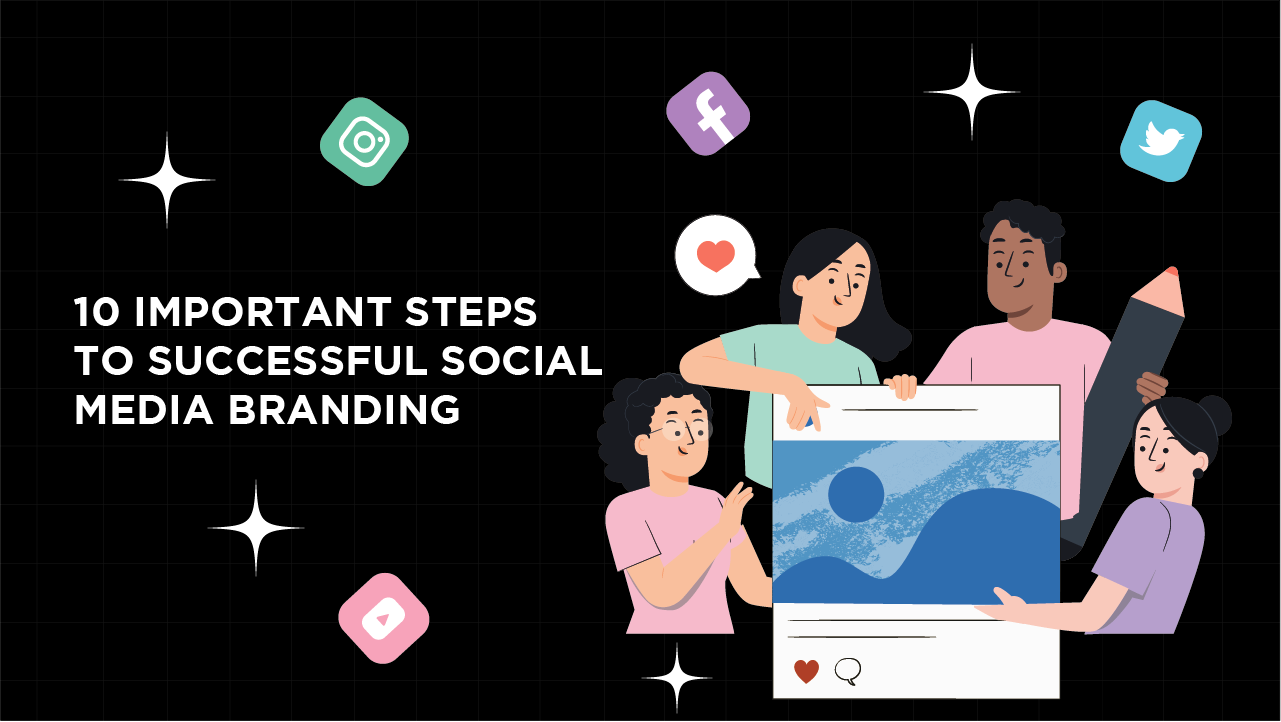Branding is critical to the success of any firm. It’s more than simply the uniform you wear to represent your firm; it’s a way of being. If done effectively, it will help you attract your target audience while also luring new clients along the way.
When it comes to social media branding for your business, there are even more factors to consider. From creating and organising social content to engaging with and your audience, and, of course, developing your online identity through a website — cultivating your social brand can become a full-time job in and of itself.
But don’t be concerned. Positioning your business on major social media platforms such as Facebook, Instagram, and Twitter can be a semi-painless (read: not effortless) chore with the appropriate direction.
We’ll walk you through the 10 actions you need to do to get started with your social media branding:
01. Identify your target audience
You had a lot on your plate when you initially started your own firm. You’ve accomplished a lot to get where you are now, from designing your own logo to learning the fundamentals of small company bookkeeping (and more). It’s now time to put everything you’ve learned into practise in your social media marketing strategy.
You’ve already started laying the basis for determining your target audience. It’s an excellent place to start for the demographic you want to attract through social media branding, as the two should not be too dissimilar. Knowing who you’re attempting to reach will help you create a brand identity that will appeal to them.
Do you need assistance? The Pew Research Centre provides a lot of information on social media usage across multiple groups. After determining which social networks your primary target group prefers, you may want to explore broadening your audience for improved reach. But proceed with caution. Casting a wide net does not guarantee that you will “net” the additional clients you seek.
02. Select the appropriate networks for your target audience.
After reviewing your audience demographics in the previous section, make sure you’re on the relevant social networks to reach them.
It is not necessary to be present on every social network. Choose accounts where you want to post on a regular basis and where your target audience is also present. It’s preferable not to have an account on a social network if you don’t intend to use it.
There is one exception, and that is Facebook. The world’s greatest social network is unavoidable, and your company should have a presence there – regardless of industry or demographic.
Aside from Mark Zuckerberg’s platform, here are some of the most important outlets to consider for your internet presence:
Social Media Platforms
- Twitter is excellent for raising awareness. Using hashtags helps you to contact people who share similar interests but are not necessarily part of your immediate target audience.
- LinkedIn: If you work in the business-to-business (B2B) market or want to target a certain business segment, the “professional” network may be a suitable fit. Posts are typically more informative than casual and entertaining.
- Instagram: The photo-sharing app is useful for both business visibility and connection building. Initially, users tended to be younger, more creative people, but Instagram is now on almost everyone’s phone, including your grandmother’s.
- Starting a YouTube channel is an efficient approach to build relationships with users and help them get to know the personality of your brand. You can make a range of videos, ranging from fun entertainment to educational how-to tutorials.
- TikTok: TikTok is a new short-form video app that has recently gained popularity among businesses because to its engaging content, wide viewership, and high rate at which posts go viral.
- Of course, each social channel has its own set of analytics, demographics, tools, and behaviours. You can review our social media marketing complete guide to learn more or brush up on your skills.
03. Create social media profiles for your company.
Surprisingly, “Business” accounts on major social media platforms (such as Facebook, Instagram, and LinkedIn) provide more business functions. If you haven’t already, you’ll need to build corporate social media accounts or convert existing ones.
These accounts not only allow you to pay to promote your posts, but they also provide useful social media analytics tools to show you how your posts are performing and provide more data about your audience on the platform.
You should verify or “claim” your business on your social media sites to appear as credible as feasible. This demonstrates to users that you are the ‘authentic’ business account for your brand name. Each social network will have its own set of rules to follow, but trust us when we say it’s simple.
You should at the very least complete your profile for each social network you join up for, even if you don’t have any social media content to share just yet. This comprises a picture or logo of your company, a branded link to your company’s website via a link shortener, and a succinct description of your company’s mission and goals.
Hope makes it simple to design the most beautiful and quickly loaded bio pages. Because it is so simply configurable and has a special search function, your followers will have never-before-seen access to your links.
04. Construct a persona
The next thing you should do is develop a persona for your online identity. Whatever you choose to call it—a social media identity, a digital personality, or a 2.0 alter ego—the most essential thing is that this persona is wholly infused with the message of your brand and radiates everything your company stands for. This in turn will have an impact on the content you create for social networks and how you respond to messages on them.
1. Discover your own voice.
Determine the initial perception that your brand has of your target market. Now, become it. Your demeanour needs to match your corporate image, whether it is serious and professional, sincere and emotional, or lighthearted and humorous.
Social media success is greatly influenced by consistency, which goes beyond simply publishing frequently. You should make sure that, despite the character limit, both responses the user receives if they post a question on Facebook and Twitter are respectful and maintain the same tone.
It’s okay to model your brand after a real person, like a celebrity, if you’re having difficulties coming up with a character as long as the personality fits your company.
2. No matter what, always be kind.
No matter how you go about creating your identity, one thing you must do is communicate with your audience as “humanly” as you can. Although you are speaking on behalf of your brand, it’s crucial that your followers perceive you as a fellow human being who genuinely cares about them rather than a company that is only interested in their hard-earned money. There’s a potential that, whether you meant to or not, you’ll also be offering customer service on social media, but that’s a completely different subject that our friends over at the Wix Answers Blog have already thoroughly covered for you.
Utilising posts from your company’s employees is another approach to humanise your brand. This gives the brand a face and humanises it. You could even go so far as to hire a spokesperson specifically to represent your brand in your content, but that is not necessary. By all means, choose that way if you want to. However, giving readers a “behind the scenes” glimpse into your company by including different employees in your postings can pique their interest.
3. Keep in mind visual branding
On the personality front, I’ve talked a lot about coordinating your business and social branding, but that shouldn’t be the end of it. It includes your visual branding as well, which includes the colours you employ and the pictures you post on social media. This will, of course, also depend on the kind of content you intend to upload, which we will discuss below, but this is a factor that will get stronger with time.
Innocent drinks is a great example of graphic branding done correctly. From its Facebook pages to its Twitter and Instagram accounts, there is a strong aesthetic theme present throughout all of these platforms. Everything in this example demonstrates how a strong brand identity can be translated into the visuals, from the cover photos on each account to the usage of venn diagrams when launching a new beverage, right down to the font style used in the photographs.
05. Begin creating (awesome) stuff
Now is the time to sit down and plan the content you’ll be releasing on a regular basis. This is a crucial component of social media, so you can’t just ignore it and expect to succeed.
Additionally, it’s critical to comprehend a few facts regarding the stuff you distribute:
One is that not every post you make needs to be about your company. Providing information to your audience that may not be directly relevant to the goods or services your company sells but still adds value to their experience is a component of content marketing. Value is crucial! Links to blogs like this one or other kinds of interesting postings, such infographics, case studies, and more, can be included in your posts. Whatever the content, it must still adhere to the tone and identity you already established for your company.
Asking users to provide material for you is another option that might be beneficial. Naturally, it’s not as simple as it seems. User-Generated Content, or UGC, is what this is. The general idea is that you encourage your consumers to take pictures or videos with your product to give a review or show how they utilise it differently. This might work best once you have gained more of a following. Another UGC strategy is to ask your customers, followers to take videos of what they do for living as pastime. And how your company has benefited them in some manner. In return, you not only get insightful input that could change the game also can post your user’s material on your social channel.
Win-win situation!
Concerned that you won’t have enough content over time? Don’t worry; it will gradually become simpler, especially after some practise. Finding or creating content for your social media platforms won’t be the difficult process it may have initially seemed to be after you gain an understanding of your audience and company identity.
Keep in mind that some of your content is time-sensitive and can only be used once, while other content can be reused or recycled into multiple pieces over time.
Still experiencing creative block? To observe the type of content that is posted every day, check out your competitors’ and other social media accounts that you admire. Go for it if you can effectively match one of these posts to your brand. You still need motivation? Take a look at some social media strategies you may use for your brand.
06. Make an online social calendar
You should arrange your material into a simple social media calendar structure once you’ve produced enough for a few weeks (yes, weeks, but more would be great). This will make it simple for you to keep track of which posts are being published to which social network and at what time.
You may design your social calendar and schedule your material to post automatically to your networks using programmes like Buffer or Hootsuite if you want to be extremely efficient. These platforms will not only give you a place to quickly create your schedule, but they also have their own handy analytics that you can use.
It’s crucial to be consistent when planning your calendar with regards to how frequently you intend to publish on social media.
The greatest posts to make in order to receive the most engagement are:
- One post every day on Facebook
- Instagram: 1-2 daily posts
- Twitter: fifteen tweets daily
- LinkedIn: One daily post
- 11 pins daily on Pinterest
- One post every day on TikTok
It’s okay if you can’t make the required or recommended amount of postings each day. Prioritise consistency and post quality, and boost when you can.
7. Use social advertising to spread awareness
A fantastic strategy to capture your audience’s attention is to promote your adverts on social media. There is absolutely no guilt in it because that is its intended use.
While promoting a post is an easy approach to draw attention to your advertisement and, consequently, your social profile, you might want to wait at first. Consider visiting an advertiser’s profile after seeing a particularly targeted ad on Instagram, only to discover that there are just two postings on the account overall. Technically speaking, there is nothing wrong with this, but it conveys the impression that the account is extremely young and lacks the credibility that a more established account with a fan base would.
Consider marketing your initial post once you have been blogging consistently for a few weeks and have enough of engaging information to share with followers. By doing this, a new prospective client can visit your profile and find a wide variety of postings to interact with. The more information you have available for people to get lost in and consume, the more likely it is that they will visit your website or other social media platforms.
8. Collaborate with influencers on social media
Working with social media influencers is another strategy, similar to social advertising, to attract potential customers. Since it’s a third party discussing your product or service rather than you making a direct sales pitch, it comes off as more natural to the viewer.
It can take time to find the perfect influencer to collaborate with. If you choose to go this route, you will need to conduct in-depth research on a specific influencer to see whether their audience is comparable to yours or one to which you are trying to appeal. Just because you’re a personal fan doesn’t mean you should go all out and try to connect with an influencer whose demographic is glaringly different from yours. You can certainly do that if you want to, but don’t count on seeing many conversions as a result.
Additionally, it is not crucial to make sure you are dealing with the biggest, most well-known name possible. Another well-liked approach is using micro-influencers, who have smaller fan bases but have enormous power over those fans. They cater to a certain niche, which may be advantageous to you if you discover that your interests and goals are compatible. Whoever you decide to collaborate with should, in all likelihood, feel like a natural fit.
09. Retain your followers’ attention.
There are other aspects of social media branding besides content creation. You should interact with your followers frequently and treat them like the community that they are. It’s a two-way street, just like any relationship. You must respond in kind! Not only is it advantageous for you because posts with higher engagement are more likely to be seen by others if they are relevant to you, but you should be doing this in any case.
Do you really want to boost engagement rates? The future is live video. A live stream creates a two-way channel for instant communication on any social media platform, including Facebook, Twitter, and Instagram. Spend some time showcasing new goods, answering followers’ questions, or simply chit-chatting. Being accessible to your audience via a live broadcast demonstrates to them your value and respect for their time, which they will enjoy. Additionally, this gives your brand a more genuine and direct humanization on a different level.
Due to careless implementation, the majority of social media brands will fail. They either have poor material, intermittent posting, or limited audience interaction. Your audience (or lack thereof) will likely not care if you participate if you consistently post irrelevant or boring content because you aren’t adding anything of value to them. You’re doing it incorrectly if you constantly publish high-quality material but don’t engage your audience by responding to comments, posing queries to them, or participating in forums.
10. Use analytics to pay attention to metrics
Understanding what works and doesn’t for your social brand is crucial for boosting it. Some of them should be evident from a content standpoint: postings with visual material will almost always perform better than a post with simple text. However, things aren’t always so simple. Black magic analytics can help you dig deep and understand your triumphs and pitfalls in a clear and measured approach.
Every worthwhile social network provides some kind of usable analytics. These tools provide information regarding the effectiveness of your postings, enabling you to strive to repeat successes and avert failures going forward. And that’s just the tip of the iceberg. You can also learn when to publish on social media and change your calendar accordingly.
You should either get over it or consider using one of the many third-party social media analytics programmes available to you if you don’t love the concept of checking each unique social network for analytics data. If you already use one of the platforms for scheduling content for your calendar, tools like Buffer and Hootsuite offer analytics as well as a variety of digital tricks up their sleeves.




